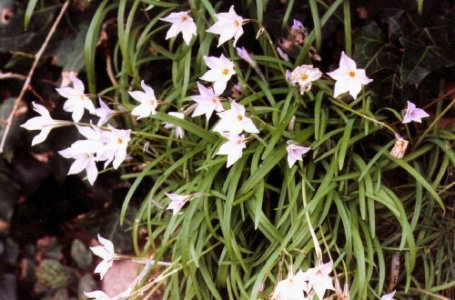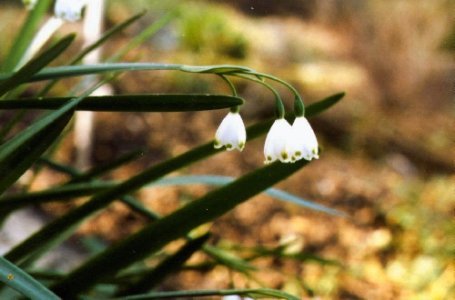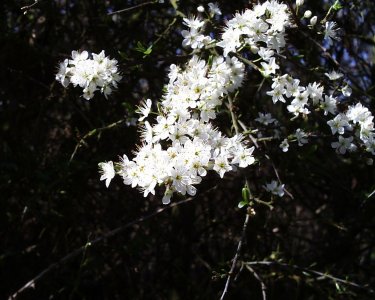
Alderney Nature Diary
March 2001
The Weather
Pressure was lower than usual throughout the month, with strong winds, mainly from the SE-SW, giving a higher than normal average speed.
Rainfall for the month, despite 7 days with none recorded, was the highest March total in our records, 2.5 times the previous 20-year's average and 3.6 times last year's amount. The total for the year to date was also a record, more than double the average and almost four times last year's total. The total rainfall for the last six months amounts to 844.05mm, (33.3 inches) against the average for October to March of 447.07mm (17.6 inches). About 61% of the year's rainfall (which averages about 730mm or 28.7 inches) usually falls during these six months, for this period the total greatly exceeds the average for a whole year. The total rainfall for 1999, which was also a very wet year, was only 870mm.
As might be expected sunshine figures were down as a result, although there were only six days without any sunshine at all, the total being about half that of last year and nearly 50 hours down on the average, recording the second least amount for March since 1955, with only 1964 lower, with 70.3 hours, and 1958, 69, 84 and 1994 having the next lowest amounts, all around 90 hours.
Temperatures were about average overall, but the strong winds made it feel colder. Night temperatures both this March and last year, were 2º above the 20-year average, whilst day temperatures were below average.
Figures for comparison with March last year and the 20-year average.
| Year | 2001 | 2000 | 20-year average |
| 1981-2000 | |||
| Rain mm. | 136.7 | 38.1 | 51.1 |
| Sun hrs. | 76.7 | 147.2 | 124.8 |
| Max. temp recorded °C | 14.6 | 15.0 | 13.6 |
| Min. temp recorded | 2.8 | 1.2 | 2.0 |
| Mean day temp | 9.0 | 9.5 | 10.3 |
| Mean night temp | 8.2 | 8.2 | 6.2 |
| Total rainfall, year to date, mm. | 395.2 | 109.3 | 179.2 |
| Total sunshine, year to date, hrs. | 234.4 | 301.8 | 260.0 |
The Diary
Regular readers of these diaries will remember my tales of the male Chaffinch which we called "Bird" visited us every year for seven years, tapping on the windows, following us from room to room and performing acrobatic displays up and down the glass outside to attract attention. Last year what I presume to be one of his sons came back and made some small attempts at this sort of contact for a time. His father always arrived in the last 2-3 days of February. This year "Bird 2" arrived on 1st March and started tapping the window of my attic library and then perching on the end of a Grape vine branch sticking through the cypress trees outside the window about a yard away and singing to me. After a day or two, he got to going up and down the full height of the window right up to the eaves, tapping as he went up and down. This performance now goes on for 5 or 10 minutes at a time intermittently throughout the day and also on the dining room and lounge windows below when I am in those rooms.
Altogether a charming sight and a very people-oriented bird. The characteristic must have been inherited. Chaffinches are common in the island, both a resident population which keeps on the open fields in the winter, and a migratory breeding population. When this happened for the 3rd year in succession, about 6 years ago, I wrote an article about "Bird" for the local 2-weekly Journal. Many people commented to me about it, and have Chaffinches regularly visiting their bird tables and hanging nuts but no-one has ever reported any similar sort of behaviour.
We now have neither bird table nor nut bags in the garden, as local cats were creating a hazard to the birds, and only put a few crumbs out, on the grass close to the house, on some days. These are generally quickly consumed by our resident Blackbirds, Song Thrushes, Dunnocks, Collared Doves, and Wrens, one pair of each appearing to live permanently in the tress and bushes surrounding our garden, and a cock Pheasant which strolls through the garden several times a day and picks up anything going. We also have two Herring Gulls which spend most of the year perched on our chimneys and swoop down immediately for any larger scraps that are put out. The pair of Mallard, mentioned last month, also visit most days in the spring, but never stay more than a short while.
4th. Bird 2 back again, this time in company with a female, who only stayed within sight for a few minutes.
6th. First Celandine Ranunculus ficaria I have seen in flower this year on a bank on Essex Hill. A patch of Primroses Primula vulgaris, flowering on top of the field wall opposite my front gate. First appeared there about 3 years ago.
16th. First "Stinking Onions" Allium triquetum of the season seen flowering in Le Petit Val near the stream at the bend half way up.
17th. First Blackthorn Prunus spinosa or P. fruticosa in flower in a roadside thicket near Rose Farm.
18th. Marsh Marigold Caltha palustris in flower in the stream-fed artificial pond established about 6-7 years ago near the tennis courts on Platte Saline. A large clump of these have emerged amongst a large (about 1.5m across), well established patch of Umbrella Sedge Cyperus alternifolius which I planted as a small plant with half a dozen stems when the pond was first established. Several smaller clumps have now established themselves round the pond. This sedge comes from Madagascar and is normally grown indoors in a pot standing in water, or in conservatory ponds. It normally reaches about 70-80cm in these conditions. In Alderney it has thrived in my garden in the ponds and in moist areas for years, reaching 120-150cm in height, standing up to frequent salt winds and occasional frosts, and self-seeding prolifically into the surrounding lawns. The Marsh Marigold may well have come from dormant seed in the clump I transplanted, as I have a small clump of it in one of the garden ponds. I first noticed it at this spot last year, but it has grown considerably now, and there was a single well grown seedling with two flowers open, about a metre away in the grass surrounding the pond. 21st. First day of Spring. Bright sunshine after 46 mm rain in the previous 36 hours opened many Celandines and a small patch of Primroses by the seat half way up Le Petit Val. Further up, in Wide Lane, near the junction, a large area was covered in Celandines, with Red Dead-nettle Lamium purpureum, Charlock Sinapis arvensis, Pink Campion Silene x hampeana, Petty Spurge Euphorbia peplus, and a whole mass of Stinking Onions all in flower here and in the banks down this lane. Sweet Alison Lobularia maritima now flowering again on the banks all down Longis Road. Large areas of Longis Common and the Campsite were flooded after the rain. Daffodils and Narcissi by the thousand now flowering on almost every bank, hedge, field margin and patch of waste ground. Mainly remnants or self-seeded from the flower growing enterprise in the 1960, as well as some more recent plantings in verges and open public areas by the States in the last 4-5 years. Gorse now making large areas turn yellow, but not fully out yet and apparently more advanced at the western end of the island than the east.
Danish Scurvy-grass Cochlearia danica, flowering all along the bottoms of the roadside walls in the Route de Crabby and elsewhere.
22nd. Bird 2 arrived in the morning with the female, again she didn't stay long, sitting on the Cypress branches outside my window for a few minutes. He stayed around the house all day, banging on all the windows in turn, wherever I happened to be.
25th Cowslips Primula veris, in flower in the Stranger's Cemetery, their only 'wild' site in the island. Small clumps of Stinking Onions now flowering all over the island, no large areas of bloom yet though.
27th. Red Deadnettle now flowering in a number of places. Round by the Old Harbour a single plant of the purple Hoary Stock Matthiola incana, in flower at the base of the jetty wall, with lots of Danish Scurvy-grass nearby, a couple of plants of Sea Carrot Daucus carota subsp. gummifer, in flower in cracks in the wall. Several plants of Groundsel Senecio vulgaris, flowering along the top of the German Sea Wall in front of Albert Terrace. This common, and in many places troublesome garden weed is comparatively infrequent in Alderney. A single small plant of Common Ramping-fumitory Fumaria muralis subsp. boraei, the commonest of our fumitories was covered in bloom and a single plant of Bulbous Buttercup Ranunculus bulbosa, lots of Daisies Bellis perennis, everywhere in the short grass here and on Platte Saline. A single plant of Guernsey Fleabane Conyza sumatrensis, in flower in my garden. First recorded in Alderney last year, here, on Platte Saline, and on Braye Common, by Margaret Long, one of the two Jersey BSBI recorders. I, and all previous Alderney records had always assumed that all our plants were the similar, and much more common, Canadian Fleabane Conyza canadensis. Just shows the importance of careful examination of some plants, with a lens, before recording them.
28th. First blooms opening on the single clump of blue Iris Iris x hollandica, in the hedge opposite my gate. This has been there some years, under Blackthorn, Bramble and Sycamore scrub and is presumably another remnant of the 1960's flower crops.
29th. Ivy-leaved Toadflax Cymbalaria muralis now flowering in old walls, a few flowers on garden bushes of Rosemary and the many patches of Elephant-Ears Bergenia crassifolia, much planted in island gardens and occasionally escaped onto verges.
30th. The Veronica hedges, Hebe x franciscana and H. salicifolia and several other cultivars are flowering again. some bushes have been flowering intermittently throughout the winter.
Gorse now much more fully open and brighter all over the island. Spring Starflower Tristagma uniflorum massed, as usual, along the base of a roadside wall in Route des Mielles, growing out of the asphalte, with another area in a dry wall at Essex Castle. Summer Snowflake Leucojum aestivum, coming into flower in The Terrace.
31st. The Blackthorn opposite my gate has burst into brilliant flower almost overnight, scarcely noticed it yesterday but the eight hours sunshine then must have encouraged it to be in full bloom today. Along the east coast at its three usual spots, our "rare and endangered species" Sand Quillwort Isoetes histrix, is present by the thousand and, here and in short turf in several other places, cliff paths, Corblets and Mannez quarries, Longis Common, etc, the minute Early Forget-me-not Myosotis ramosissima, Shepherd's Cress Teesdalia nudicaulis, Three-fingered Saxifrage Saxifraga tridactylites, and Common Whitlow-grass Erophila verna, were all in flower to end the month.

Spring Starflower

Summer Snowflake

Blackthorn